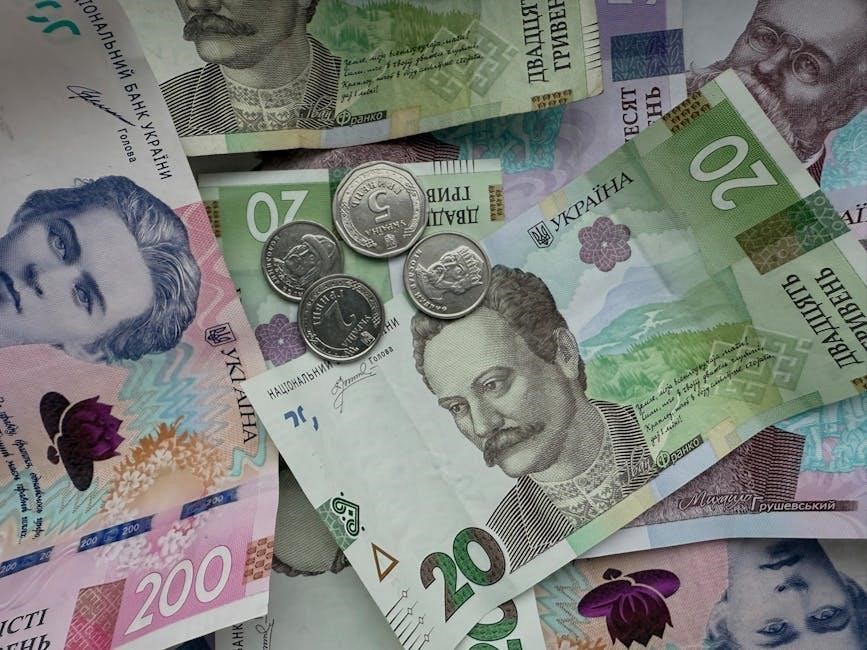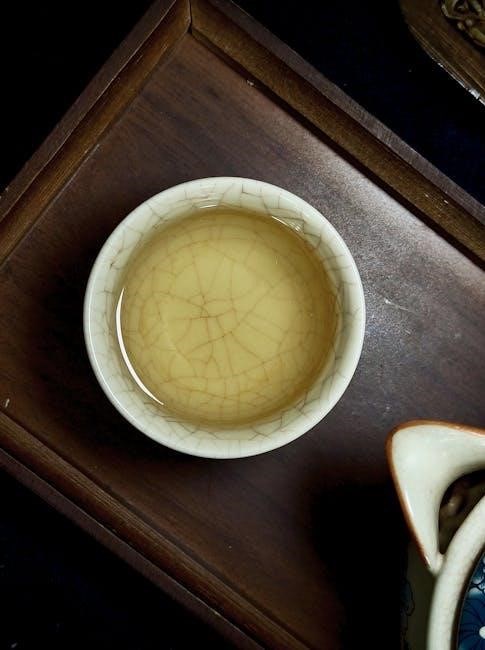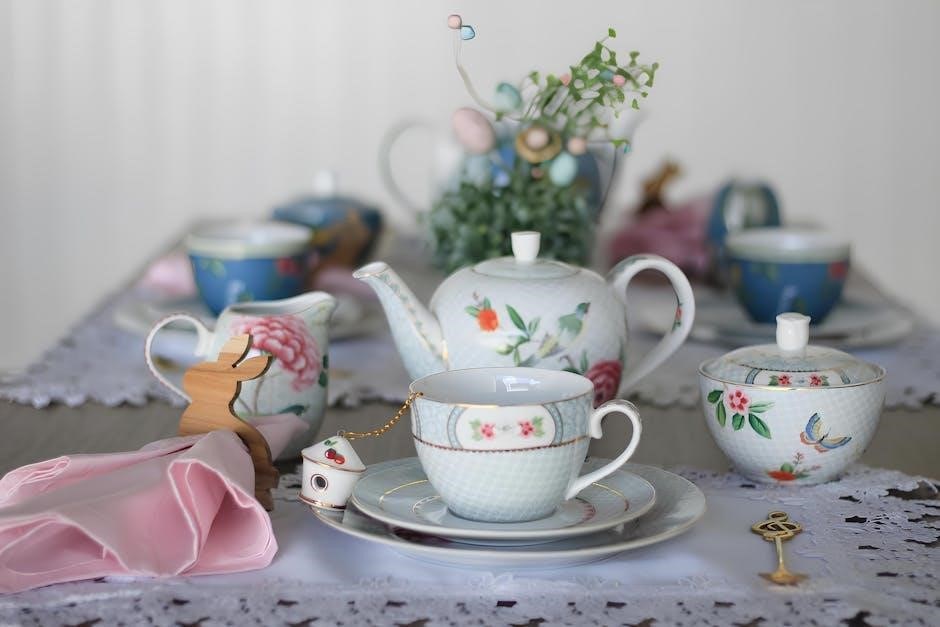Meissen Porcelain Identification and Value Guide ― An Overview
Meissen porcelain, renowned for its crossed-swords mark, captivates collectors globally; understanding its history, marks, patterns, and value is crucial for proper identification.
Historical Significance of Meissen Porcelain
Meissen porcelain holds immense historical weight, representing a pivotal moment in European ceramics. Before its emergence in the early 18th century, Europe heavily relied on imported porcelain from the East, particularly China. Augustus the Strong, Elector of Saxony, passionately desired to unlock the secrets of porcelain production, viewing it as a symbol of wealth and power.
His relentless pursuit led to the establishment of the Meissen manufactory, marking the first successful European hard-paste porcelain. This achievement not only diminished dependence on Eastern imports but also spurred a flourishing artistic and economic era. Meissen quickly became synonymous with luxury and innovation, influencing porcelain production across the continent and establishing a lasting legacy of craftsmanship and artistic excellence.
The Founding of the Meissen Manufactory
The Meissen manufactory was officially founded in 1710, though its origins trace back to alchemist Johann Friedrich Böttger’s discovery of a porcelain formula in 1708. Augustus the Strong, captivated by the potential, established the factory near Dresden, in the town of Meissen, utilizing a fortress as its initial location.
Early production focused on replicating Chinese porcelain styles, but quickly evolved to embrace uniquely European designs. Key figures like Johann Gregor Höroldt played a crucial role in refining the manufacturing process and developing distinctive Meissen aesthetics. The manufactory’s early success was fueled by royal patronage and a commitment to artistic innovation, quickly establishing Meissen as a premier porcelain producer.

Decoding Meissen Marks: A Comprehensive Guide
Meissen porcelain marks, particularly the crossed swords, are vital for authentication and dating; understanding their evolution and variations unlocks a piece’s history.

The Crossed Swords Mark – The Core Identifier
The crossed swords mark is undeniably the most recognizable symbol associated with Meissen porcelain, functioning as the world’s oldest trademark. Initially adopted in 1720, it wasn’t consistently used until 1731, becoming the definitive identifier for genuine pieces. Early iterations were painted in blue, and variations in the sword’s shape and the surrounding decoration evolved over centuries, offering clues to the production period.
Understanding the nuances of this mark – its color, form, and placement – is paramount for collectors. The mark’s presence doesn’t guarantee authenticity, as forgeries exist, but its accurate depiction is a fundamental starting point for identification. Examining the quality of the mark itself, alongside other characteristics, is essential for a reliable assessment.
Early Marks (1720s ― 1730s): Augustus Rex and Initial Symbols
During the manufactory’s nascent years (1720s-1730s), Meissen porcelain bore a variety of marks preceding the standardized crossed swords. Pieces often featured the monogram of Augustus Rex, the Elector of Saxony and King of Poland, who founded the factory. These early marks were frequently painted in blue and could include various symbols, such as stars, scrolls, or other decorative elements.
The “KPM” mark, representing Königliche Porzellan-Manufaktur (Royal Porcelain Manufactory), also appeared during this period. Identifying these initial symbols requires careful study, as they are less consistent than later marks. These early markings signify some of the rarest and most valuable Meissen pieces, demanding expert evaluation for accurate attribution.
Evolution of the Crossed Swords Mark (1731-Present)
The iconic crossed swords mark underwent significant evolution from its official adoption in 1731. Initially, the swords were often curved and painted in blue underglaze. Over time, the swords became straighter and more defined, with variations in their length and the space between them.
Throughout the 18th and 19th centuries, subtle changes occurred, reflecting different painting styles and factory directors. In the 20th century, the mark was sometimes incised, particularly on biscuit porcelain. Today, the crossed swords remain a globally recognized symbol of Meissen quality, though variations exist, necessitating careful examination to determine authenticity and production date.
Incised Marks vs. Painted Marks: Understanding the Difference
Distinguishing between incised and painted Meissen marks is vital for accurate dating and authentication. Incised marks, typically found on biscuit porcelain from 1774-1814, are carved into the clay before firing, offering permanence. These are often simpler, featuring just the crossed swords.
Painted marks, applied after firing with cobalt blue, are more common and varied. They evolved over centuries, offering clues to production periods. Painted marks can be underglaze or overglaze. Understanding these differences, alongside the mark’s clarity and style, helps determine a piece’s age and origin, crucial for assessing its value and verifying its authenticity.
Painter’s Marks and Model Numbers: Additional Clues
Beyond the iconic crossed swords, Meissen porcelain often bears painter’s marks and model numbers – invaluable details for identification. Painter’s marks, typically initials or symbols, identify the artist responsible for the decoration, impacting value based on their renown. These marks reveal individual craftsmanship.
Model numbers, impressed into the clay, denote the specific design or form. Knowing these numbers allows referencing Meissen’s extensive archives, confirming authenticity and production dates. Combining these clues with mark analysis provides a comprehensive understanding of a piece’s history, origin, and artistic merit, aiding accurate valuation and provenance research.

Dating Meissen Porcelain
Dating Meissen relies on analyzing marks, stylistic evolution, and form changes; these elements collectively pinpoint production periods, aiding accurate identification and valuation.

Using Marks to Estimate Production Dates
Meissen porcelain marks are invaluable for estimating production dates, though deciphering them requires careful study. The earliest marks, from the 1720s, featured the monogram of Augustus Rex, often alongside initial symbols denoting the painter or decorator. The iconic crossed swords emerged around 1731, undergoing numerous modifications over centuries.
Early crossed swords were often painted in blue, later evolving to impressed or incised forms. Changes in the sword’s shape, the addition of dots or stars, and the surrounding decoration all provide clues; For instance, incised marks on biscuit porcelain were common between 1774 and 1814. Understanding these variations, alongside the presence or absence of specific elements, allows collectors to narrow down the approximate age of a piece, though it’s rarely a precise science.
Style and Decoration as Dating Indicators
Beyond marks, Meissen porcelain’s stylistic evolution offers crucial dating clues. Early 18th-century pieces often showcased Rococo designs, characterized by delicate floral patterns and asymmetrical compositions. The mid-18th century saw the rise of the Onion Pattern (Zwiebelmuster), becoming an enduringly popular motif. Later periods embraced Neoclassical influences, featuring more restrained forms and mythological scenes.
Analyzing painting styles is also key. The quality and detail of the hand-painted decoration, the color palettes used, and the subject matter all reflect prevailing artistic trends. Examining the form and modeling – the shape and sculptural details – reveals changes in manufacturing techniques and aesthetic preferences over time, aiding in accurate dating assessments.
Form and Modeling: Changes Over Time
Meissen porcelain’s forms dramatically evolved, reflecting shifting tastes. Early pieces (1720s-1740s) often featured bulbous shapes and elaborate, asymmetrical designs, influenced by Eastern porcelain. As techniques improved, forms became more refined and symmetrical during the Rococo period. The Neoclassical era (late 18th century) brought streamlined silhouettes and classical motifs.
Modeling, particularly in figurines, also underwent transformation. Early figures were often smaller and more stylized. Later, sculptors achieved greater realism and anatomical accuracy. Observing the base of figurines – its form, decoration, and presence of incised marks – provides valuable dating information. Subtle changes in handle shapes, spout designs, and overall vessel construction further aid identification.

Key Meissen Porcelain Patterns and Designs
Meissen is celebrated for iconic patterns like Onion (Zwiebelmuster) and Red Dragon, alongside diverse figurines depicting people, animals, and mythological scenes—highly collectible!
The Iconic Onion Pattern (Zwiebelmuster)
The Zwiebelmuster, or Onion pattern, is arguably the most recognizable Meissen design, originating around 1730. Its enduring appeal stems from a captivating blend of Eastern and Western artistic influences. The pattern features a stylized depiction of onions, peaches, and floral sprays, often painted in vibrant cobalt blue underglaze.
Initially inspired by Chinese porcelain imported through the Dutch East India Company, Meissen artisans adapted the motifs to create a uniquely European aesthetic. Variations exist, including those with added gilding or different floral arrangements. Identifying authentic Zwiebelmuster requires careful examination of the painting style, the quality of the porcelain, and, of course, the presence of a genuine Meissen mark. Pieces in excellent condition command significant value among collectors, representing a timeless symbol of Meissen artistry.
Red Dragon Pattern and Other Popular Motifs
Beyond the famed Onion pattern, Meissen produced a diverse array of captivating motifs. The Red Dragon pattern, popular in the 18th century, showcases a vividly painted dragon amidst foliage, often reflecting Chinoiserie influences. Other notable designs include the “Indianische Blumen” (Indian Flowers) and various bird and landscape scenes.

These patterns demonstrate Meissen’s versatility and skill in adapting decorative styles. Identifying these motifs requires familiarity with Meissen’s historical catalog and painting techniques. Variations in color, detail, and execution can significantly impact value. Collectors prize pieces exhibiting exceptional artistry and well-preserved detail. Examining the quality of the porcelain body and the clarity of the mark are also crucial steps in assessing authenticity and worth.
Figurines: Identifying Common Subjects and Sculptors
Meissen figurines are highly sought after, depicting a range of subjects from allegorical figures and mythological scenes to everyday life and animal studies. Common themes include harlequins, musicians, and depictions of the aristocracy. Identifying the sculptor is key to valuation; renowned artists like Johann Joachim Kändler significantly increase a figurine’s worth.
Kändler’s playful monkeys and elaborate court scenes are particularly prized. Examining the base for impressed or painted model numbers aids identification. Condition is paramount – chips, cracks, or restoration drastically reduce value. Understanding the stylistic evolution of Meissen figurines across different periods is crucial for accurate assessment and appreciating their artistic merit.

Assessing Meissen Porcelain Value
Meissen value hinges on rarity, condition, demand, and provenance; the crossed-swords mark, combined with these factors, determines its worth in the antique market.
Rarity and Condition: Primary Value Drivers
Meissen porcelain’s value is profoundly influenced by its rarity and condition, often outweighing even historical significance. Limited-edition pieces, unusual patterns like the Red Dragon, or those crafted by celebrated sculptors command premium prices. Pristine condition—free from chips, cracks, repairs, or excessive wear—significantly elevates value. Even minor imperfections can substantially decrease worth.

Collectors meticulously examine pieces for evidence of restoration, as repairs, however skillfully executed, diminish collectibility. Original paint, gilding, and glaze are highly prized. Pieces retaining their original luster and detail are far more valuable than those that have been over-cleaned or altered. The interplay between scarcity and preservation dictates a piece’s desirability and, consequently, its market price.
Demand and Market Trends
Meissen porcelain’s value fluctuates with prevailing market trends and collector demand. The iconic Onion Pattern consistently remains popular, but interest in specific figurines or decorative styles can surge and wane. Economic conditions significantly impact the luxury goods market, influencing purchasing power and investment strategies.
Currently, there’s a growing appreciation for pieces with documented provenance, linking them to notable collections or historical events. Online auction platforms and specialized dealers play a crucial role in shaping market prices, providing transparency and accessibility. Geographic demand also varies; Meissen enjoys strong followings in Europe, North America, and increasingly, Asia, impacting global pricing dynamics.
The Impact of Provenance on Value
Meissen porcelain’s value is dramatically enhanced by a well-documented provenance – a clear history of ownership. Pieces linked to aristocratic families, significant collections (like Powerscourt), or historical events command premium prices. Provenance establishes authenticity and adds a narrative, appealing to collectors seeking more than just aesthetic beauty.
Detailed records, including old invoices, auction catalogs, or family histories, are invaluable. Pieces formerly held in renowned collections often carry prestige, increasing desirability. Even a connection to a notable previous owner can substantially elevate value. Establishing provenance requires diligent research and, sometimes, expert authentication to verify claims and maximize a piece’s market worth.

Common Fakes and How to Spot Them
Beware of reproduction marks and inconsistencies in painting style; analyzing porcelain quality and clay composition is vital to distinguish genuine Meissen from fakes.
Identifying Reproduction Marks
Detecting counterfeit Meissen porcelain often begins with scrutinizing the marks. Reproduction marks are a primary indicator of fakes, frequently mimicking the iconic crossed swords. However, subtle differences exist. Early reproductions may attempt to replicate the original incised marks, while later fakes often feature painted marks that lack the crispness and precision of authentic examples.
Pay close attention to the execution of the swords themselves – are the lines clean and well-defined, or blurry and uneven? Examine the surrounding details, such as the dot or star often accompanying the swords; inconsistencies here are red flags. Furthermore, be wary of marks that appear “too perfect,” as genuine marks often exhibit slight variations due to the hand-painting process. Researching known reproduction marks and comparing them to the piece in question is a crucial step in authentication.
Analyzing Porcelain Quality and Clay Composition
Authentic Meissen porcelain boasts a distinctive hard-paste porcelain composition, developed in the early 18th century. Examining the body of the piece reveals a fine, almost glassy texture. Genuine Meissen feels substantial and emits a ringing tone when tapped, unlike softer, more porous imitations. The clay itself is typically white, though variations can occur depending on the period and decoration.
Under magnification, authentic Meissen exhibits tiny, glittering quartz particles within the porcelain body. Fakes often utilize lower-quality materials, resulting in a duller appearance and a less refined texture. Analyzing the glaze is also crucial; genuine Meissen glaze is smooth and even, while reproductions may exhibit imperfections or a cloudy appearance. Professional analysis can determine the precise clay composition, confirming authenticity.
Recognizing Painting Style Inconsistencies
Meissen porcelain painting evolved significantly over time, making stylistic analysis vital for authentication. Early pieces (1720s-1730s) showcase delicate, often naive, painting styles influenced by Japanese Imari. Later periods demonstrate increasing realism and refinement. Forgers often struggle to replicate the nuanced brushwork and color palettes of skilled Meissen painters.
Look for inconsistencies in detail, perspective, and anatomical accuracy. Genuine Meissen features precise rendering of figures and floral motifs. Reproduction pieces frequently exhibit blurred lines, uneven coloring, or awkward compositions. Pay attention to the application of gilding; authentic Meissen gilding is typically bright and durable. Comparing the painting style to known examples from specific periods is crucial for identifying discrepancies and potential fakes.
Resources for Further Research
Online databases, auction records, and specialized books offer invaluable insights. Expert appraisals and authentication services provide definitive assessments of authenticity.
Online Databases and Auction Records
Numerous online resources facilitate Meissen porcelain research. Websites dedicated to antique marks, like those referencing Dresden pottery marks, can aid initial identification. Auction house databases – Christie’s, Sotheby’s, and Bonhams – provide realized prices for comparable pieces, establishing market value benchmarks. These records reveal trends and demonstrate how condition, rarity, and provenance influence selling prices.
Furthermore, specialized Meissen porcelain databases, though often subscription-based, offer detailed catalogs of patterns, shapes, and marks. Examining past auction results helps determine if a piece is a genuine antique or a later reproduction. Careful comparison of details – including the precision of the crossed swords mark and the quality of the painting – is essential when utilizing these resources for accurate valuation.
Books and Publications on Meissen Porcelain
A wealth of literature exists for those seeking in-depth knowledge of Meissen porcelain. Comprehensive guides detail the evolution of Meissen marks, from the early Augustus Rex symbols to the modern crossed swords. Publications focusing on specific patterns, like the iconic Onion Pattern (Zwiebelmuster), offer detailed histories and variations. Books dedicated to Meissen figurines catalog common subjects and identify notable sculptors.
Scholarly works explore the manufactory’s history and artistic influences, providing context for understanding its creations. Auction catalogs from reputable houses often include detailed descriptions and provenance information. These resources are invaluable for verifying authenticity, dating pieces, and appreciating the artistry behind this celebrated porcelain.
Expert Appraisals and Authentication Services
Determining the authenticity and value of Meissen porcelain can be complex, necessitating professional expertise. Qualified appraisers specializing in porcelain offer accurate valuations for insurance, sale, or estate purposes. Authentication services employ advanced techniques to verify the originality of pieces, identifying reproductions and fakes. These experts meticulously examine Meissen marks, porcelain quality, and painting styles.
Reputable auction houses often provide appraisal and authentication services. Independent appraisers, certified by recognized organizations, offer unbiased assessments. Utilizing these services safeguards against purchasing forgeries and ensures a fair market value for your Meissen treasures.


